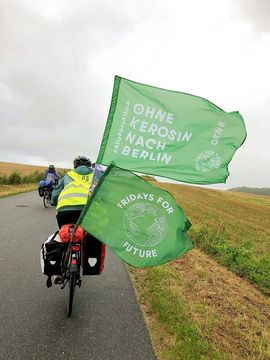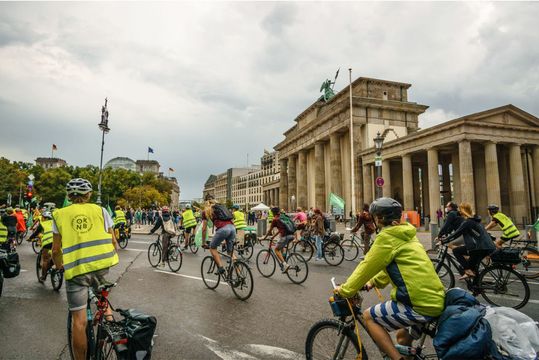

Taking to the streets
“Wir sind hier, wir sind laut, weil ihr uns die Zukunft klaut” (literally: We’re here, we’re loud, because you’re stealing our future). That’s a chant you’ll hear a lot at climate marches here in Germany. Young people now regularly take to the streets in large numbers to demand climate action and climate justice. By raising their collective voice, they are putting pressure on political leaders to do more to respond to climate change – as a matter of the utmost urgency.
Their concerns are echoed by UN Secretary-General António Guterres, who warns that the world is headed for a climate “catastrophe” unless we take immediate action. Global warming is with us already and is getting steadily worse. In the summer of 2022, for example, Germany experienced record heatwaves, with the mercury climbing to over 40°C for the first time ever. And in Canada, one location even came close to 50°C.
And yet there are those in denial, who say it’s not that bad. But the overwhelming consensus of scientific opinion says categorically otherwise. Indeed, the IPCC “Climate Change 2023” Synthesis Report warns that climate change is happening faster and with more devastating consequences than previously thought.
„The climate crisis is here. It is unmistakeable."
Luisa Neubauer
You may recall the terrible floods in the Ahr valley. In the immediate aftermath, Luisa Neubauer issued the following stark warning: “” Neubauer is one of Germany’s best-known climate activists. She is the spokesperson for and one of the main organisers of the German arm of the “Fridays for Future” movement. The movement’s aims include ending coal use by 2030 and meeting the Paris target of limiting global warming to a maximum of 1.5°C.
“Fridays for Future” now has over 600 local groups all over Germany. Other activist movements have also formed, including “Students for Future” and “Scientists for Future” at Germany’s higher education institutions, and “Parents for Future” in the wider community. In Germany, many students feel morally bound to join with other socially conscious young people to raise awareness of the dire consequences of climate change and to help counter them.
„Shaken from our complacency by children and young people”“
Climate activist Moritz
Moritz Böll is one such student. He attended his first “Fridays for Future” strike in 2019. “Finally, I could work with like-minded people and give voice to my anger and profound unhappiness at the wilful destruction of our planet and disregard for human rights”, he says. Back then, the protests were spearheaded by high school students.
University-age students have since joined their ranks. “We were shaken out of our complacency by children and young people. Suddenly, I felt ashamed of my generation’s political apathy. Today, the climate movement has a presence in all parts of society. People have become more politically aware, including us students.”
Moritz is studying at the University of Cologne and is an activist with “Students for Future”. He is one of the organisers of the “Public Climate School” climate education and awareness campaign. He also helps organise and takes part in the “Ohne Kerosin nach Berlin” (To Berlin Without Kerosene) nationwide cycling protest tour.
It’s hard work, cycling hundreds of kilometres to Berlin, but it’s worth it to raise awareness of climate change. Plus, it’s an excellent way to connect with more people and encourage them to take a stand. Being a climate activist keeps Moritz pretty busy. “But it’s hardly a burden. Quite the opposite in fact: I find it very energising and encouraging to be working alongside other motivated people championing climate justice, sustainability and democracy. I’ve learned so much from this form of social and political engagement.”
The movement is open to all. “We’re especially happy to welcome people from other countries as they bring fresh ideas and perspectives”, says Moritz. “The climate crisis is global, so the response needs to be global too.”
„We’re especially happy to welcome people from other countries as they bring fresh ideas and perspectives“
Moritz
Natuka, a 20-year-old student from Georgia, joined four months ago and supports the “Students for Future” group in Hamburg. “I got involved because I believe that the university, as a leading educational institution, can be a major driver of change in society and can mobilise people to act with urgency, before it’s too late”, she says. She is one of few international students involved with Students for Future in Hamburg.
“But I hope more will get on board once they realise that the social problems they’re confronted with on a daily basis are increasingly a product of climate change, so by solving the climate problem, they will also solve the social problems.” Thirty years ago, in Natuka’s home country of Georgia, the people took to the streets to fight for their independence and freedom. “Here, I think we sometimes forget how much power ordinary people have. But we shouldn’t. Our entire history is built on demonstrations, on people standing up for their freedoms and rights, for better government and more positive action.”
One of Natuka’s aims is to motivate her fellow students – and everyone else, for that matter – to support the climate movement.
It all began, of course, in Sweden with Greta Thunberg. In 2018, aged just 15, she began taking Fridays off school to protest outside the Swedish parliament. Holding a sign reading Skolstrejk för klimatet (School Strike for Climate), she called for stronger action to meet the Paris climate goals and reduce CO2 emissions.
Inspired by her example, millions of students all around the world began taking to the streets in protest instead of attending school. And so was born the international “Fridays for Future” movement.
In Germany, the first demonstrations were organised in early 2019 by Luisa Neubauer. At first only a handful of students took part, but within just a few months their ranks had swelled to over 1.3 million students nationwide.
The COVID-19 pandemic put something of a damper on the activities of “Fridays for Future” in Germany, but the movement regained momentum in early 2023 amid a wave of protests in the North Rhine-Westphalian farming village of Lützerath.
The village is scheduled for demolition so that the vast reserves of lignite (aka brown coal) that lie beneath it can be mined. The hotly contested rationale is that the lignite is needed to safeguard Germany’s security of energy supply. The first villagers were relocated back in 2005, and all legal bids to block the village’s destruction have since been rejected by the courts. Outraged, climate activists began occupying the abandoned village in 2020, demanding that it be spared and that the coal beneath it be left in the ground. The main focus of the protest was a compromise agreement reached between the North Rhine-Westphalia state government, the Federal Ministry of Economic Affairs and Climate Action, and the energy company seeking to mine the lignite.
Under that agreement, the coal phase-out in North Rhine-Westphalia will be brought forward from 2038 to 2030, and the originally planned mine will be reduced in size, leaving some 280 million tonnes of lignite in the ground and sparing five other villages. But, crucially, the mining will go ahead, and lignite will be extracted. “Fridays for Future” and others are opposed to this, arguing that coal is no longer needed at all for electricity generation, and that 100 percent renewable energy by 2030 is the only way for Germany to meet the 1.5 degree target set under the Paris agreement.
Lützerath was not spared by the compromise deal, and so the climate protesters continued their occupation. The village had become a rallying point for the climate movement – a symbol of Germany’s “addiction to coal”. It all came to a head in January 2023, when the police began evicting the protestors from the village. In response, thousands of climate activists all around the country took to the streets in solidarity with the occupiers in Lützerath. Using the hashtag #Lützibleibt – Lützi is short for Lützerath, so loosely translated the hashtag says “Lützerath stays” – climate activists showed solidarity with the protesters in the Rhineland.
The occupiers are now gone, and the village is to be destroyed. But the eviction of Lützerath was a watershed moment for the climate movement, and the activists of “Fridays for Future” continue to fight for climate justice. Some have given up in frustration, feeling that nothing has changed. But many feel strengthened in their resolve, and new supporters are joining the movement all the time.
Their motivation: to raise awareness of the fact that climate change is a major existential threat to humankind. “Fridays for Future” has awoken public consciousness around climate change and is sparking needed questioning and debate.